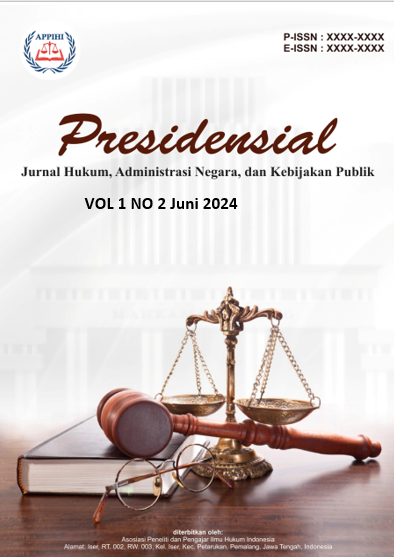Rekonstruksi Pengaturan Tentang Suap Dan Gratifikasi Dalam Upaya Mewujudkan Kepastian Hukum
DOI:
https://doi.org/10.62383/presidensial.v1i2.27Keywords:
Corruption, Gratification, Corruption PreventionAbstract
Article 12B Paragraph (1) within the Law of Corruption Offenses bears resemblances to provisions regulating bribery offenses (Article 11, Article 12 letter a, letter b, and letter c), subsequently posing challenges in the implementation of law enforcement. Nonetheless, this article also demonstrates several advantages, including the introduction of the reversal of the burden of proof imposed on the defendant. In the effort to fortify the regulation pertaining to gratification offenses, reconstruction is required in several aspects. Firstly, the definition of gratification needs to be elaborated and clarified to avoid interpretation uncertainties. Secondly, the importance of mandatory reporting regulations concerning gratification receipts is crucial in realizing transparency in corruption prevention. Furthermore, precise gradation is needed regarding the elements of the articles and the threat of punishment for bribery and gratification offenses, including distinguishing between various types of gratification. To sustain effective law enforcement, it is recommended that the government evaluates Article 12B Paragraph (1) and undertakes reconstruction in accordance with the outlined suggestions. These steps are expected to address the regulatory overlaps between bribery and gratification, while strengthening the legal foundation to comprehensively combat corruption offenses.
Downloads
References
Ali, H. Z. (2011). Metode Penelitian Hukum. Jakarta: Sinar Grafika. Retrieved from https://ekazai.wordpress.com/makalahartikel-hukum/hukum-pidana/makalah-gratifikasi/
Collins Thesaurus of the English Language-Complete and Unabridged 2nd Edition. Retrieved from http://www.thefreedictionary.com. Accessed 16 September 2018.
Departemen Pendidikan Nasional. (2005). Kamus Besar Bahasa Indonesia (h. 942). Jakarta: Balai Pustaka. Accessed 16 September 2018.
Garner, B. A. (1999). Black’s Law Dictionary (h. 1278). St. Paul, MN: West Group. Accessed 16 September 2018.
Hamzah, A. (1997). Korupsi di Indonesia (Masalah dan Pemecahannya). Jakarta: PT. Gramedia Pustaka Utama.
Kementerian Pendayagunaan Aparatur Negara dan Reformasi Birokrasi. (2014). Retrieved from http://www.menpan.go.id/daftar-kelembagaan-2. Accessed 26 February 2014.
Lopa, B. (2000). Kejahatan Korupsi dan Penegakan Hukum (Cetakan Pertama). Jakarta: Kompas.
Marbun, B. N. (1996). Kamus Politik (h. 469). Jakarta: Pustaka Sinar Harapan. Accessed 16 September 2018.
Mauliddar, N., Din, M., & Rinaldi, Y. (2017). Gratifikasi sebagai Tindak Pidana Korupsi terkait Adanya Laporan Penerima Gratifikasi. Kanun Jurnal Ilmu Hukum, 19(1), April.
Mulyadi, L. (2007). Pembalikan Beban Pembuktian Tindak Pidana Korupsi. Bandung: Alumni.
Prasetyo, T. (2014). Hukum Pidana (Edisi 1, Cetakan Ketiga). Jakarta: Rajawali Pers.
Qordhawi. (1997). Responsi Hukum Pidana: Penyertaan dan Gabungan Tindak Pidana. Bandung: Armico.
Rahardjo, S. (n.d.). Hukum Dalam Perspektif Sosial.
Scally, G. (n.d.). Defining Corruption: A Comparison of the Substantive Criminal Law of Public Corruption in the United States and United Kingdom. As cited by Kusumasari, D. in “Perbedaan antara Suap dengan Gratifikasi”. Retrieved from http://www.hukumonline.com/klinik/detail/cl3369/perbedaan-antara-suap-dengan-gratifikasi
Waluyo, B. (1996). Metode Penelitian Hukum. Jakarta: Sinar Grafika.
Wiyono, R. (2008). Pembahasan Undang-Undang Pemberantasan Tindak Pidana Korupsi. Jakarta: Sinar Grafika.
Yuniar, T. Kamus Lengkap Bahasa Indonesia. Jakarta: Penerbit PT. Agung Media Mulia. Retrieved from http://repository.unpas.ac.id/43871/2/BAB%20II.pdf






